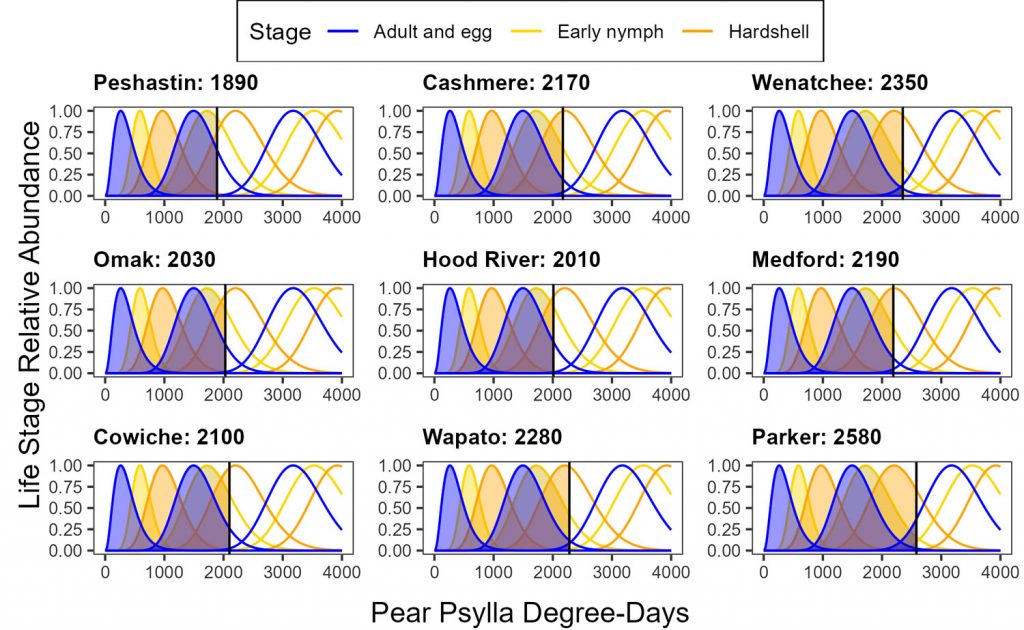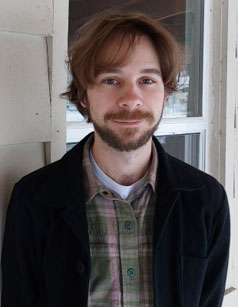Written by Robert Orpet, WSU, June 2023
What we are doing and what we have found
The Pear Insects Lab at WSU has been testing pest management guidelines for pear since 2022 on commercial farms. Our goal is to develop an integrated pest management program that costs less and results in less pest damage than conventional management in the Wenatchee Valley.
In last month’s Fruit Matters, I showed how integrated management in spring 2022 and 2023 suppressed first-generation pear psylla just as good as conventional. Now, in summer 2023, we are towards the end of pear psylla’s second generation.
Let’s define how management programs on the project differ during summer:
- Conventional pear orchards rely on insecticides like Rimon 0.83EC, Delegate WG, Actara, Imidacloprid, Agri-Mek SC, Assail 70WP, and Bexar.
- With integrated management, the goal is to keep biocontrol agents alive while preventing pear psylla damage. Management options are as follows:
- Codling moth: mating disruption, Altacor, Intrepid, virus, and oil.
- Mites: Vendex 50WP, Envidor 2SC, and Nealta
- Pear psylla: phenology-targeted applications of particle films, Ultor, Cinnerate, azadirachtin, oil, washing off honeydew with water, and summer pruning.
- Organic management is similar to the integrated approach but has fewer pesticide options.
Now, how do management outcomes differ?
- As expected, there are temporarily more pear psylla nymphs (and more honeydew) in integrated and organic orchards than in conventional orchards during summer (Fig. 1B). This was seen last year too (Fig. 1A).
- There are a lot less pear psylla this year than last year across management styles. Note the difference in y-axis scales for nymphs between 2022 and 2023 in Fig. 1.
- Compared with last year, natural enemies of pear psylla (including Campylomma, Deraeocoris, and Trechnites) are active in greater numbers, earlier, and more consistently across integrated and organic orchards. They are practically absent in conventional orchards.
- Earwigs have not been found in conventional orchards on the project. These pear psylla predators evidently cannot survive in conventional orchards, and they take several years to re-establish naturally in integrated or organic orchards.
Finally, let’s look ahead…
- Conventional orchards lack beneficials and can be expected to risk third-generation pear psylla outbreaks near harvest time, like last year. Every year, we observe huge production of pear psylla adults in conventional orchards (Fig. 1A, top chart), probably contributing to our high areawide pear psylla pressure in the Wenatchee Valley.
- Integrated and organic orchards can be expected to have less damage than last year, when second generation pear psylla caused very sticky conditions. Pear psylla can be expected to be low during the third generation, like last year, especially given that natural enemies are already more abundant than in 2022. If all goes well, no more pear psylla sprays are needed fin the integrated management program at this point. Biocontrol will do the job.
- In 2022, conventional programs on the project last year averaged around $1400 in pesticide materials, and integrated orchards spent $140 less. Damage was, on average, similar between management styles last year. You can expect a report on end-of-season costs and damage between management styles in 2023 in a future Fruit Matters issue and in Pear Entomology Weekly.

Resources and Opportunities
- To continue following along with weekly pest data from Wenatchee and Yakima like in Figure 1 and receive free pear psylla degree-days like in Figure 2, you can subscribe to Pear Entomology Weekly using this conveniently shareable web form. To see the latest issue without subscribing, here is a sample issue from June 30, 2023.
- Look out for announcements for public meetings of the public Pear Pest Management Discussion Group advertised in Pear Entomology Weekly. Open to everybody, come to share your experiences and learn from others.
- If you would like free earwigs to jumpstart populations in your integrated or organic pear orchard (or apple orchard), check out the Earwig Transit Workshop webpage, and RSVP for a July 12 with this web form.
Contact
Robert Orpet
WSU
robert.orpet@wsu.edu
Funding and acknowledgements
Thank you Fresh Pear Committee and Processed Pear Committee in addition to WSDA for pear orchard research and Western SARE Project #WRGR23-004 for funds supporting related to earwig workshops.
Additional information
- Learn about pear psylla management
- Get pear psylla degree-days for free
Fruit Matters articles may only be republished with prior author permission © Washington State University. Reprint articles with permission must include: Originally published by Washington State Tree Fruit Extension Fruit Matters at treefruit.wsu.edu and a link to the original article.
Use pesticides with care. Apply them only to plants, animals, or sites listed on the labels. When mixing and applying pesticides, follow all label precautions to protect yourself and others around you. It is a violation of the law to disregard label directions. If pesticides are spilled on skin or clothing, remove clothing and wash skin thoroughly. Store pesticides in their original containers and keep them out of the reach of children, pets, and livestock.
YOU ARE REQUIRED BY LAW TO FOLLOW THE LABEL. It is a legal document. Always read the label before using any pesticide. You, the grower, are responsible for safe pesticide use. Trade (brand) names are provided for your reference only. No discrimination is intended, and other pesticides with the same active ingredient may be suitable. No endorsement is implied.


